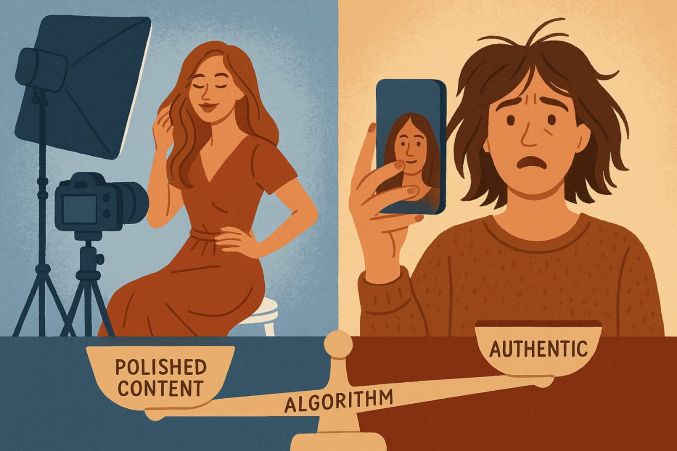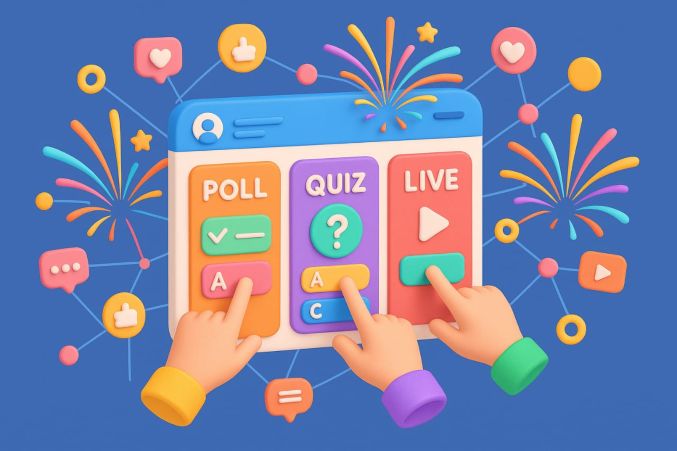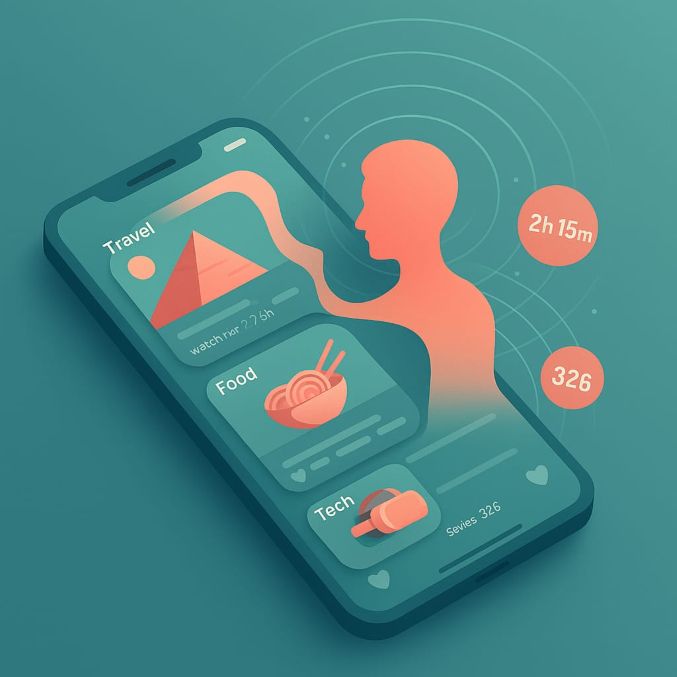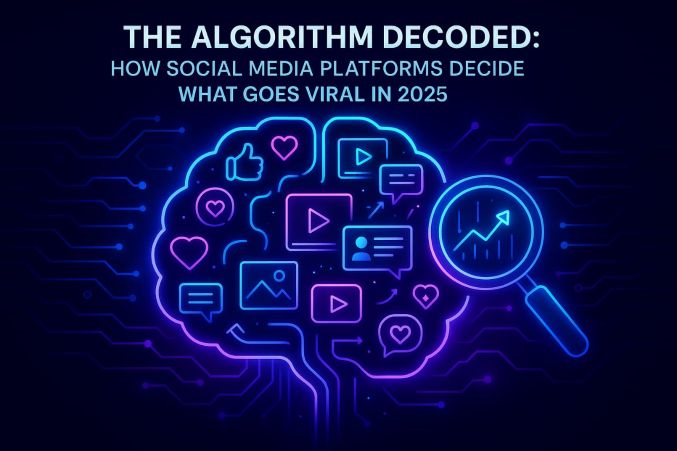The Algorithm Unravelled: How Social Media Platforms Determine What Goes Viral in 2025
Social media algorithms of 2025 are intelligent, instinctive, and more intent on serving up hyper-personalized experiences. The era of random virality is passing—nowadays, platforms use AI, engagement signals, and contextual relevance to decide what pops up on users' feeds.
If you're a content creator, marketer, or company attempting to unlock the secret, becoming aware of these changes is essential. Let's dissect the first five influential factors behind virality in 2025.

1. The Algorithm Revolution: What's New in 2025
Those days are over when simple shares and likes controlled reach. In 2025, social algorithms have become predictive, behavior-based models that favor:
AI-Driven Personalization – Algorithms now consider user activity in real time, learning from micro-interactions (dwell time, re-watching, swipes) to forecast preference.
Deeper Engagement Indicators – Comments, saves, and shares are still important, but "meaningful interactions" (extended watch time, replies, and direct messages) carry greater weight.
Contextual Relevance – AI cross-checks user interest, trending topics, and even real-world events to deliver timely, hyper-relevant content.
Why It Matters
If your content is not withstanding a user's historical behavior or trending now, it will not catch on—regardless of its quality.
2. AI-Driven Personalization: Your Feed, Just for You
Social media in 2025 no longer just curates feeds—it anticipates what users are likely to want even before they click. Here's how:
Behavioral Micro-Tracking: Each tap, pause, and scroll is studied. If you sit longer on a cooking video, anticipate more recipe material—even if you never used to like or follow food pages.
Cross-Platform Learning: Meta (Facebook, Instagram), TikTok, and Google now exchange behavioral data (with user permission) to improve suggestions.
Dynamic Content Tuning: AI adjusts captions, thumbnails, and even video pacing based on what engages users.
Key Takeaway
Generic content gets lost. To succeed, produce niche, highly engaging content that appeals to your audience's subconscious tastes.
3. Authenticity Now Rules The Algorithm
Refined, overproduced content is falling out of favor. In 2025, unfiltered, raw posts work better because:
User Trust Decline – After decades of influencer mess and artificial trends, audiences yearn for real, authentic content.
Algorithmic Bias Toward "Real" Signals – Sites recognize compelled engagement (e.g., "Like this post!") and demote them.
The Dawn of "Behind-the-Scenes" Content – Relaxed, unedited videos (iPhone recordings, fast rants, or rough work-in-progress footage) experience better retention.
Pro Tip:
Forget about over-editing. Document, don't produce. Reveal bloopers, frustrations, and raw moments—they connect better.
4. The Short-Form Video Revolution
Reels, Shorts, and TikTok-style videos reign in 2025. Why?
Shorter Attention Spans – Average watch time prior to scrolling is less than 2 seconds.
Algorithmic Preference for Video – Platforms prioritise video over static because it leads to longer session lengths.
Vertical-First Design – Mobile-first, full-screen videos receive 3x higher engagement than landscape videos.
Winning Strategy:
Hook in 0.5 seconds (text overlays, bold imagery, or a question).
Enforce re-watchability (buried details, Easter eggs, or fast-cutting).

5. Interactive Content Wins: Polls, Live, and UGC
Passive scrolling is dead. In 2025, content that requires engagement flourishes:
Polls & Quizzes – Instagram Stories polls, Twitter/X "vote" features, and LinkedIn quizzes engage users for longer.
Live Streams & Real-Time Chats – Live interactions are rewarded with priority visibility on platforms.
User-Generated Content (UGC) – Brands using customer testimonials, duets, and reaction videos gain increased trust and reach.
Why This Works:
Interactive content gives more powerful engagement cues to the algorithm, informing it: "Users aren't just watching—they're participating."
6. Trust, Safety & Credibility: The 'Quality' Factor
The days of clickbait and rage-bait's reign over feeds are over. In 2025, platforms strongly penalize disinformation and reward high-quality, transparent sources. Here's how:
How Algorithms Identify "Quality" Content
Fact-Checking AI – Platforms now match claims against vetted databases in real-time.
Author Reputation Scoring – Posting history, corrections, and source citations impact reach.
User Feedback Loops – If several users flag misleading content, it gets shadow-banned or demoted.
What Wins?
✅ Verified professionals (doctors, scientists, industry experts) receive algorithm boosts.
✅ Sourcing transparency (linking to studies, citing references) boosts trust signals.
✅ Balanced views (steering clear of absolute bias) rank higher than polarized opinions.
Key Takeaway:
If your content is manipulative or misleading, the algorithm will bury it. Focus on accuracy—even if it is slower growth.
7. Social Search & SEO: Optimize for Discovery, Not Just Engagement
Forget mere hashtags—social SEO has become a top growth driver. TikTok, Instagram, and YouTube have more emphasis on search intent than virality.
How Social Search Works in 2025
Keyword-Optimized Captions – Algorithms analyze text for semantic intent (e.g., "best running shoes for flat feet" versus mere #RunningShoes).
Voice Search Integration – Because of the growth of voice queries, conversational queries (e.g., "How do I repair a leaky faucet?") get better ranking.
Visual Search (Pinterest, Google Lens) – AI searches images and videos for objects, text, and context to match user search.
Winning the Social SEO Game
-Apply long-tail keywords in captions (e.g., "budget-friendly skincare routine for sensitive skin").
-Include subtitles—AI scrapes them for search indexing.
-Tap trending questions (AnswerThePublic, Google's "People Also Ask").
Pro Tip:
Think like Google, not merely a social creator. Optimize for search-first discovery.
8. Community, Private Groups & Niche Networks
Public feeds are getting noisy and clogged. The actual engagement? It's shifting to private groups, Discord servers, and niche platforms.
Why Private Communities Succeed
Greater Trust – Users open up more in closed environments.
Algorithm Incentives – Platforms favor "meaningful conversations" (lengthy threads, substantive discussions).
Fewer Competitors – In contrast to public feeds, private groups aren't overwhelmed with brands.
Where to Invest in 2025
Facebook Groups (still a leader for niche communities).
Discord & Telegram (for dedicated fanbases and direct interaction).
Reddit-style sub-communities (Instagram's "Channels," LinkedIn subgroupings).
Top Strategy:
Don't merely broadcast—create a tribe. Algorithm prefers in-depth engagement vs. vanity metrics.

9. New Tech: AR, Voice & Decentralized Networks
The next wave of virality is not only what you share—it's how users interact with it.
Augmented Reality (AR) Supremacy
Virtual try-ons (makeup, apparel, furniture) generate 3x more engagement.
Interactive filters (games, quizzes, 3D effects) make users stay on your content longer.
AI-created avatars (for personalized storytelling).
Voice & Social Audio's Return
Voice notes (WhatsApp, Instagram) are overtaking text DMs.
Podcast clips (on TikTok, YouTube Shorts) become popular.
AI voiceovers (for accessibility and multilingual reach).
Decentralized Social Media (Web3)
Blockchain-based platforms (Mastodon, Lens Protocol) compensate creators directly.
NFT-gated content (exclusive posts for token owners).
User-owned data (no longer shadow-ban fears).
Future-Proof Your Strategy:
Experiment with AR filters, voice content, and Web3 platforms before they reach mainstream saturation.
10. Algorithm Ethics: Privacy, Transparency & User Control
Users (and regulators) are tired of manipulative algorithms. By 2025, platforms need to find a balance between personalization and privacy.
Key Ethical Shifts
"Algorithmic Choice" – Users now have the ability to opt out of AI-generated feeds (Instagram's "Chronological Mode," for example).
Data Minimization – Less tracking = fewer creepy ads.
EU's Digital Services Act (DSA) & US Regulations – Platforms are required to explain why content is suggested.
What This Means for Creators
Fewer hacks based on dark arts (follow/unfollow, engagement pods).
More emphasis on real value (or lose reach).
Transparency is key (reveal sponsorships, corrections).
Biggest Takeaway:
Growth for growth's sake is over. Ethical, sustainable strategies triumph in the long run.
11. Action Plan: How to Win (Without Gaming the System)
Rolling it all up, here's your 2025 Algorithm Playbook:
1. Be Authentic (Not Perfect)
Drop the over-produced content. Real > polished.
Share bloopers, struggles, and unfiltered moments.
2. Optimize for Search & Social SEO
Make use of keywords in captions.
Answer frequently asked questions in your niche.
3. Prioritize Interactive Content
Polls, quizzes, live Q&As = algorithm gold.
Ask people to save and share (not just like).
4. Build a Community (Not Just an Audience)
Participate in private groups, Discord, niche forums.
Have two-way conversations.
5. Test New Tech
Experiment with AR filters, voice content, and Web3 sites.
Get ahead before they get oversaturated.
6. Play the Long Game (Ethically)
No more spammy hacks or shortcuts.
Trust = the ultimate growth hack.
Final Thoughts: The Future of Virality
Virality in 2025 is no accident—it's AI-designed, trust-based, and deep-engagement-driven. The winners? Those who pivot quickly, remain authentic, and respect the algorithm's evolution.
What’s your biggest algorithm challenge right now? Drop it in the comments—let’s crack the code together!


Comments
No Comments To Display